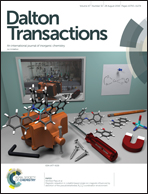Tunable and ultra-stable UV light-switchable fluorescent composites for information hiding and storage†
Abstract
Advanced fluorescent materials have demonstrated great value in the anti-counterfeiting field for information storage and hiding. In this work, a novel strategy for producing UV light-switchable fluorescent patterns to hide and store information is proposed based on carbon dots (CDs) and Y2O3:Eu composites with exceptional optical properties. CDs can present blue emission under both 254 nm and 365 nm UV light excitation, but Y2O3:Eu can only arouse a red color under 254 nm light excitation. Under conventional 365 nm excitation, a single blue color and partial information are shown, however, the whole information in patterns can be displayed under specific 254 nm excitation. The functional anti-counterfeiting patterns are made by screen printing using as-prepared polyvinyl alcohol (PVA)-medium fluorescent inks. Moreover, the hidden information retained its integrity after printed patterns were exposed to an ambient environment for 90 days. Such invisible, tunable and ultra-stable fluorescent patterns utilizing 254 nm UV light well achieve information hiding and storage and increase information security for anti-counterfeiting applications.



 Please wait while we load your content...
Please wait while we load your content...